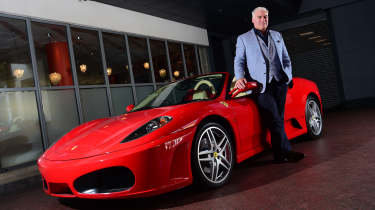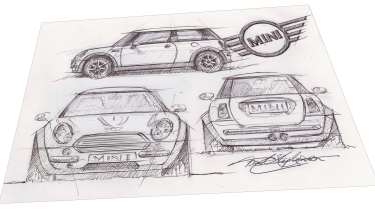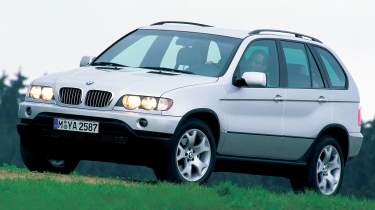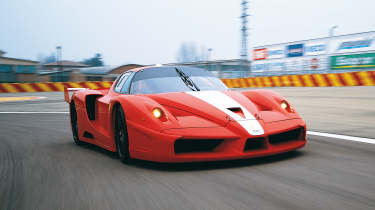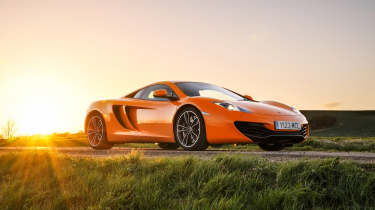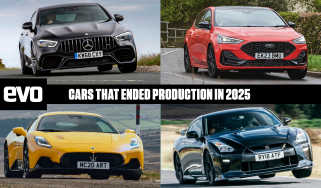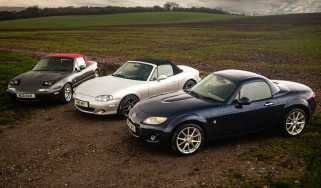My Life & Cars – Frank Stephenson, car designer
From New Mini to McLaren, via Fiat, Ferrari and countless others, Frank Stephenson’s work is everywhere you look in the automotive world. Here he talks to evo about his remarkable career to date
If Frank Stephenson had been an even better motocrosser, he might never have designed the new Mini, numerous Ferraris and most McLarens of the modern era. ‘I was kind of surrounded by cars from the earliest age but I wasn’t really incredibly passionate about them, I wasn’t dreaming about becoming involved in some future career,’ he says. ‘In my last year of high school, a friend invited me to watch one of his motocross races and help out a bit. I’ve always had bikes in my blood and as soon as I saw what it was all about, you know, the sound of two-strokes, the smell of bean oil... I guess that’s what gets you addicted to motorcycles!’
Stephenson was also attracted by the physicality of the sport and proved good at it. He had no plans to go to university and would probably have joined the family business – his father and uncle started a car dealership in Málaga, Spain, in the ’60s, selling Saabs, SEATs, Minis and Rovers – so he asked his father if he could take a year off to race bikes before starting. His father agreed: ‘He said, “Let’s get it out of your system.”’
‘That didn’t happen,’ laughs Stephenson. ‘It just got more intense. I started winning a lot sooner than I imagined and it just went from there. I got to quite a high level. It was a huge part of my youth.’ He rode competitively for four years until both he and his father realised he wasn’t going to be the very best. ‘When I was 22 my father said, “Look, if you want to really make something of your life, you have to be the number one.”’ Stephenson had always been interested in art at school. ‘I was the kid that was drawing birthday cards. I did all the artwork for the school yearbooks, and I was really into lettering, calligraphy.’
He also subscribed to an Italian design magazine called Auto & Design in which he saw an article about a university in California that was teaching car design. ‘It appealed to me right away.’ He applied, not knowing the odds against getting a place but reckoning they were very serious about teaching because they placed 90 per cent of their graduates in the design studios of the world’s car makers. The university was the Art Center College of Design in Pasadena, California. ‘The first day was a real eye opener,’ recalls Stephenson. ‘They told us the very small number of people they accept for the courses, so you feel very, very lucky. And then they sort of cut you down to size when they tell you that only around ten per cent get through the four years. They make it so hard to ensure that those that do finish are professional material. Thirty of us started, all of us very high calibre, but only six of us finished, survived.’
His dedication to motocross – four years of striving to be the best, to get the best out of himself and stay focused – would help him stay the distance. ‘The workload level was incredibly high. Forget about any social life. If you take time off it’s like stopping a marathon and starting up again – you just can’t get back into the pace.’ Classes ran from 9am to 10pm, Monday to Friday, and from 9am to 4pm on Saturday. ‘When you got home at night it was another three or four hours of work before you could get to bed. Sundays were trying to get everything finished in time for your next week’s work. It was constant pressure. And the competition was incredibly tough. You start thinking there’s no way I can get up to the level of some of the other students... and that’s where the hard work kicks in. Hard work beats talent sometimes.’
Not only was it intense, it was expensive too. Stephenson was lucky to live rent-free with a wealthy family who wanted someone to house-sit when they travelled, and was also grateful to get the backing of Ford midway through. ‘Two years in, the big OEMs made a trip out to the university for a presentation of our work.’ Ford liked what they saw and offered to pay for the rest of Stephenson’s course and give him a position when he graduated, which was a huge relief. ‘When I started with Ford, it was like a walk in the park. The stress levels and the workloads went so far downwards it felt like kindergarten stu . You come out so wired, so highly prepared that you’re ready for anything and you expect it to continue
like that. Those who make it through have that snap, that creative snap, there’s nothing like writer’s block. You’re either wired that way or you get wired for it. I have zero problems with creativity. Actually, a lot of us have too much creativity. It’s always like trying to hold back the horse.’
Stephenson was sent to Ford’s studio in Cologne,Germany. ‘It was incredible, probably one of the best training grounds for a designer, because of the size of Ford and the many different projects they had going on. There were designers from many different countries around the world and we had a lot of fun. When I started I was working on hubcaps for the Sierra programme. I got super excited when I saw them in production. You stand back and tell your mother: “See that wheel? That’s my design!” ’Then along came the Escort RS Cosworth project, which saw Stephenson part of a team working with Ford’s aerodynamicists to create the rear wing. The wild two-deck one made it to production but until very late it was going to be an even wilder three-deck design. ‘Every time we saw it we were like ‘this is going to be the biggest, coolest thing ever in the world of motorsport’. Then at the very end they needed to take some money out of the project and it was emasculated.’ Stephenson enjoyed Cologne, the lifestyle, the language, having the autobahn on the doorstep and the Nürburgring down the road, plus company cars that included an XR3i and Escort RS Turbo. But after five years he got ‘a bit antsy’.
‘I thought, there are plenty of car companies in Germany. If I had my choice, where would I go? Mercedes was stodgy, Audi was number three, Opel was nowhere and Porsche seemed to be stuck in a corner with a lot of their design language; it was
almost like, how much can you change it without changing it? It had to be BMW. So I wrote to them and said I’d be interested in working for them. This was early ’91.
‘They replied saying that they weren’t hiring at the moment but said come down and have an interview, let’s see who you are. I went along and they said, “Yeah, look, sorry. Your portfolio is great. If you’d like to start with us immediately we’ll offer you a job.” I started there in July ’91 and again, I just fell in love, with BMW, the car culture, the people working there and Munich, the most northerly Italian city. It was fabulous. I had a great time there.’
In ’94 BMW acquired Rover Group and there was lots to do. Stephenson was first tasked with exploring what a BMW version of a Land Rover would look like. ‘They wanted it very quickly, so it was a very accelerated programme. They’re the best because nothing takes forever; one day to the next you see a lot of progress.’ Stephenson’s design would become the X5.
Then came the Mini. Production of the original was due to finish in ’99 and BMW decided they’d make a new version. ‘They were a bit sensitive to the fact that we could get it wrong and the world would blame the Germans for destroying an English icon, so everybody knew the importance of getting it right.’ Instead of keeping it as an in-house design project, BMW invited designers from across the group to submit proposals: four designers at Rover Group in Coventry, five at Designworks in California (owned by BMW) and five from BMW, including Stephenson. Giugiaro did one too, resulting in 15 full-size clay models being presented to the BMW and Rover chiefs at the Heritage Motor Museum, Gaydon, in October 1995.
It was a very open brief, the only stipulation being a minimum length of 3.6m, which is what the engineers had calculated, with the chosen drivetrain, would be the minimum required for a five-star crash rating for the US market. ‘The variation in proposals was huge,’ says Stephenson. ‘Do you want to be very literal and just basically blow it up to that size? Or do you want to go really exotic, be as innovative as the original Mini and forget what the original Mini looked like? And there were guys who went down that route. So we had everything from the proportionately increased to the ones that just landed from outer space and we don’t know where they came from.’
There were seven board members from Rover, seven from BMW, and it was 14-0: all went for Stephenson’s proposal. ‘My father had Minis in the dealership, my brother’s first car was a Mini, so I had this love for Minis. My design was a genetic continuance; I thought the original was too precious and too full of unique character to just toss that away.’
Stephenson spent most of the next five years in England on secondment from BMW, working with Rover engineers to get the car into production. As a consequence, he didn’t get involved that much with his boss Chris Bangle’s work. ‘For me, flame surfacing was design for design’s sake; it wasn’t really needed. He radically changed the look of BMW. If BMW was getting hit for its designs, then you could understand the change. And that’s why I don’t understand where BMW is at now. They are getting hit for the design, and they’re not changing. They’re like: “We’re sticking to our guns. You guys just can’t see it yet. Bear with us.” No, no, we don’t want to...’
Stephenson was excited about expanding the new Mini range but his stock had risen and he was getting calls from car makers around the world. One that piqued his interest offered him ‘a great position with a very well-respected company’. They sent him a plane ticket for an interview in Turin.
‘I thought, ah, Fiat. No way; in 2002 they were less than average. But I went down anyways just for a short interview... and came back with the offer to work as Ferrari-Maserati’s first ever design director, which left me flabbergasted and overwhelmed with a bit of imposter syndrome. Somebody must have told them ‘that guy’s good’ and they trusted them, so before they could say no, I signed with them!’
‘It was... amazing. If you’re into cars and you’re suddenly living and breathing the air around Maranello and Modena, you’re thinking where does it go from here? I’m in heaven and I’m still on earth. The Enzo was just coming out, we were finishing up the 612 Scaglietti, the Maserati Quattroporte was coming out. There was a lot of work on the table, projects I would be leading: the Maserati GranSport, the Ferrari F430, the FXX – the super Enzo – the MC12...’
‘I came in a little bit shocked, thinking I’m either gonna get fired in the first year because they realise that it’s not me they should have hired or I’m gonna have the time of my life. And I had the time in my life. All the projects turned out really well and everybody was happy. I was eating pizza all the time, living on the same street as Amedeo Felisa...’
His only regret was that he never got a company Ferrari. He had an Alfa 156, two Breras and a 164 but, he says, no one drove a Ferrari. ‘Not even Felisa. I don’t think Ross Brawn or Jean Todt drove one. I never saw Montezemolo in one. But there were a lot of test drives on Fiorano with Dario Benuzzi, a lot of fun laps with Schumacher and Barrichello. I had some great experiences on the test track but, yeah, never got a Ferrari.’
Then in April 2006 they sent him off to Turin to lead the Fiat Group. ‘I didn’t want to go in any way, shape or form, because I was just living it up in Maranello and Modena, but Fiat were doing really badly and needed a kickstart really quickly.’ And he had exactly the expertise they needed: turning the neat new Fiat 500 concept car, the Trepiùno, into a production car. It delivered: Fiat has now sold over 2.5 million.
Then came another call out of the blue. It was a headhunter representing McLaren. ‘Surprised the heck out of me,’ says Stephenson. ‘I said I think you got the wrong guy. I don’t design Formula 1 cars. They said, “Who said anything about F1? They’re building an automotive branch. Most of the team is in place, they just need a design director.” ‘Following that, I met with Antony Sheriff, McLaren Automotive’s Renaissance man and [then] CEO. He gave me the opportunity to start from scratch, a clean sheet of paper: “I’ll set you up with a studio here at the Technology Centre and you can create your own team.” That was the ultimate “cherry on the cake”!
‘Ron Dennis is the ultimate detail freak, which really resonates with me, because I’m probably worse than Ron in that sense. I’ve come to realise I’m probably the most OCD person I’ve ever met in my life, and that it’s probably why I am who I am. So it really appealed to me. I thought it’s never gonna get better than this. Moving to McLaren was the most amazing experience ever because it was all about creation. ‘Ron said, “You’ve got ten years to get McLaren Automotive to the level of Ferrari in terms of respect. And you have to create your own design language. We don’t want to copy anything from anybody.” We did the MP4‐12C very quickly, not too much flash, and then we got to let go with the P1, then the 650, 675, 720...
‘I wanted to work with the absolute smallest team I could get away with. I think it’s the best formula. Everybody has to be fired up and super passionate, enthusiastic and overloaded with work, but when you’re actually privileged to be working in the design office everybody welcomes work, as much as they can get. It’s like a banquet, a feast. There were all-nighters to get the projects done but you’re on a high. The challenge was to be Ferrari in ten years and we did it in nine.
‘I’d had the best career I could ever imagine, but when I had to think: do I spend another ten years at McLaren, ride out my career here and just repeat another sports car and other supercar, another hypercar...? I just thought, it’s not where I want to end up. And I just know that every time I’ve changed, it’s gotten better for me.’ Maybe if McLaren had offered him a McLaren company car he would have stayed. ‘I never got one. I am angry about that,’ he laughs. ‘You were allowed to get a McLaren at a good price if you were at that certain level. I came that close and it was pulled away from me. I would have been the proud owner of a 675LT.’
In 2018 he left, set up his own design agency, announced it on LinkedIn, and sat back to see what came in. ‘One of the very first things that popped into my inbox was: “Can we have a conversation regarding the new age of mobility?”’ It was from a German start-up called Lilium, which was creating an eVTOL – an electric Vertical Take-Off and Landing craft. ‘It seems like science fiction. They’re basically call-up taxis that will transport you at relatively low altitude, about 1000 metres, so non pressurised, at 150 to 200mph for 45 minutes to an hour. So your range is not huge but you can live farther from the centre of, say, London, in cheaper areas. The fare will be comparable to what an Uber would cost.’
He’s now designed eVTOLs for three different companies. ‘I’ve learned from each one. They’re the most amazing-looking aircraft because they look like they were born in nature. They’re not like a sausage with wings attached; they look more like fish because fish are more hydrodynamic.’ Stephenson is the target audience, though Marlow, west of London, where he lives with his family, is hardly a cheap area. There’s still no supercar in the garage but he’s always had a greater affinity with bikes, so there’s a Ducati 1198 ‘FS’ (a one-off and ‘my pride and joy’) and an old Land Rover Defender (‘like a comfy, old pair of jeans’).
It’s not been solely eVTOLs. Other projects include Babyark, ‘the world’s safest child car seat’, which uses military technology developed for high-explosive, high-energy situations such as landmines. Currently he’s working on a new mass-volume car for a new OEM and an AI-enabled supercomputer that will solve weather predictions.
This is combined with stunning racing liveries, disruptive beauty products and cargo e-bikes. ‘Seriously, I couldn’t ever believe it,’ he says, ‘but I’m working on projects that are more exciting and have a much wider application than anything I could have ever done in the automotive world. We’re just getting busier and busier. Again It’s a fight to keep the studio small and tight, because the more projects you get, the more intense it is, but it’s very satisfying.'
This story was first featured in evo issue 308

